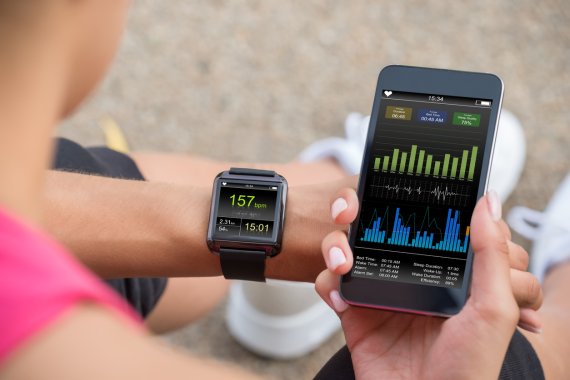The next generation of the Apple Watch is expected to be released in September as usual. Apple might completely change the design for the first time since the launch. Leakers expect a much more angular case that will also be available in several colors - an iMac for the wrist, so to speak. Apple fans will (perhaps) find out how comfortable the edges feel when worn in the fall. Above all, they hope that Apple will work on the biggest weakness of its smartwatch, the battery life. Even after years of development, the winner of the product test, the Apple Watch Series 6, does not last more than one day. This is all the more annoying for anyone who wants to analyze their sleep with the watch on their wrist. Because it has to be plugged in at night. The noticeably smaller and for the first time double-sided S7 chip of the Watch Series 7 as well as the new shape could finally provide more space for the battery and thus longer runtimes. There is also talk of a more robust outdoor version called the Explorer Edition, which is more or less a smartwatch SUV.
While Android can keep up with Apple's iPhone software iOS in most areas, Google's smartwatch operating system Wear OS looks bleak. The software has not been fundamentally updated since Wear OS 2 was released in early 2017. The functions and operation of the watches from Huawei, Oppo or Fossil are correspondingly outdated. It is therefore no wonder that only about 40 million Android smartwatches have been sold since 2016 according to chip supplier Qualcomm. But that is supposed to change. And quickly. On August 11, Samsung presents its Galaxy Watch 4 - the first smartwatch that runs with the completely newly developed Wear OS 3. The Koreans have even said goodbye to their own operating system Tizen for this. Google promises more apps, more speed and more possibilities for manufacturers to customize the interface. However, only very few of the Android watches sold so far are updated to Wear OS 3. Those who want the Google upgrade usually need a new watch.
Both the Apple Watch 6 and the Galaxy Watch 3 now provide their users with a medically recognized ECG that sounds an alarm when abnormal values are detected. Since an update in the spring of 2021, Samsung's watch also offers blood pressure measurement - but it is still very complicated. The watch has to be calibrated with a conventional blood pressure cuff. The most anticipated new health function of smartwatches is blood glucose measurement without a prick through the skin. Samsung could bring it as early as this year as a big attraction of the Galaxy Watch 4. Apple, as usual, will probably wait until the blood glucose check really works reliably and conveniently in 2022 or 2023. A miniature optical spectrometer on the underside of the watch analyzes biomarkers in the blood, which can be used to determine the sugar level. A medically reliable measurement should only take around 20 seconds. The market and the demand are huge: in the USA alone, around one in ten people is diabetic and could thus save themselves the annoying prick. Swiss researchers are already working on using the green light emitted by smartwatches to measure the pulse to stimulate the body's insulin production. The process, which first requires the injection of genetically modified cells, could make insulin injections superfluous in a few years.
Most observers agree that the pandemic will continue to accompany us despite all the progress made in vaccination. Smartwatches are becoming an important aid in enabling us to go about our daily lives as normally as possible despite this. In the future, they will be able to warn users of a possible corona infection at an early stage. In a U.S. study, the sensors in the watches detected indications of a possible infection as early as seven days before the onset of initial symptoms such as cough, fever or loss of taste. This works because the sensors detect even the most minimal deviations in heart rhythm, which are typical of Corona, at an early stage. Those who receive a warning from their watch can be tested early - and are less likely to infect other people if they become infected. Professor Rob Hirten of Mount Sinai Hospital in New York explains the "Apple smear" this way: "We already knew that markers of heart rate variability change when inflammation develops in the body. And covid is an incredibly inflammatory event. It allows us to predict that people are infected before they know it." Related apps are already in the works.
The new operating system watchOS 8 runs on the Watch Series 7 (probably again starting at around 430 Euros) - perhaps Apple should work on its confusing numbering. The update will not only work on the new Watch model from fall 2021, but will also be available as a free update for the predecessors Watch Series 3, 4, 5 and 6 as well as for the somewhat lower budget model SE (starting at 300 Euros). Restriction: Due to the weak processor, not all new features will be available on the Watch Series 3. Apple promises, among other things, new photo functions for the watch faces, more options for smart home control, digital house and car keys, a completely redesigned music app, and even more health functions such as sleep breathing analysis. New fitness focuses include Pilates and Tai Chi. If you're curious and want to try out watchOS 8 right now, you can register at Apple and download the beta software.

With their countless sensors, the latest smartwatches are absolutely high-tech - at least inside the watch case. The wristbands, on the other hand, are "only" chic, provide variety and, above all, bring Apple a lot of money in the till. But they have nothing to do with technology. That is likely to change. A prototype of the Apple Watch Series 3 from 2017, which has only just surfaced, shows where the journey could lead. It has several contacts on the rail for the wristbands, the likes of which have not been seen before. These contacts are likely to support smart wristbands. This would allow Apple or even other manufacturers to outsource sensors from the watch to the wristband. There would be more room to measure blood pressure or insulin levels on the wrist - or to extend battery life with a thin, flexible battery. It is still unclear whether and when such a novelty will come. But one thing is certain: the time for even smarter smartwatch functions is far from over.
The current smartwatches with their countless sensors are absolutely high-tech - at least inside the watch case. The wristbands, on the other hand, are "only" chic, provide variety and, above all, bring Apple a lot of money in the till. But they have nothing to do with technology. That should change. A prototype of the Apple Watch Series 3 from 2017, which has only now surfaced, shows where the journey could go. It has multiple contacts on the rail for the wristbands, the likes of which have not been seen before. These contacts are likely to support smart wristbands. This would allow Apple or even other manufacturers to offload sensors from the watch to the wristband. There would be more space to measure blood pressure or insulin levels on the wrist - or to extend battery life with a thin, flexible battery. Whether and when such a novelty will come is still unclear. But one thing is certain: the time for even smarter smartwatch functions is far from over.
- Awards
- Mountain sports
- Bike
- Fitness
- Health
- ISPO Munich
- Running
- Brands
- Sustainability
- Olympia
- OutDoor
- Promotion
- Sports Business
- Textrends
- Triathlon
- Water sports
- Winter sports
- eSports
- SportsTech
- OutDoor by ISPO
- Heroes
- Transformation
- Sport Fashion
- Urban Culture
- Challenges of a CEO
- Trade fairs
- Sports
- Find the Balance
- Product reviews
- Newsletter Exclusive Area
- Magazine





